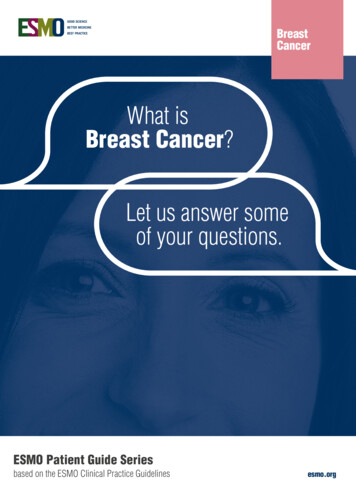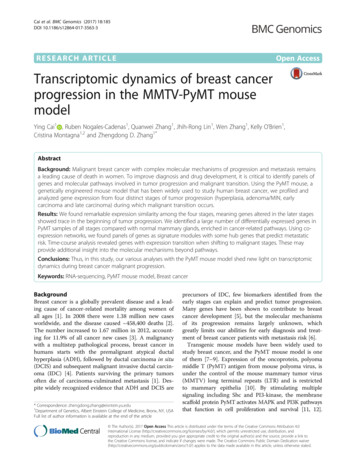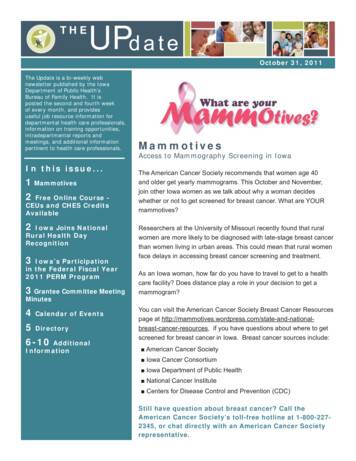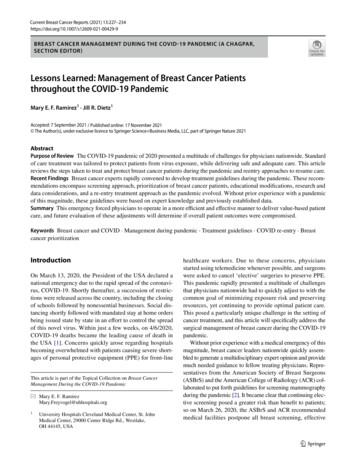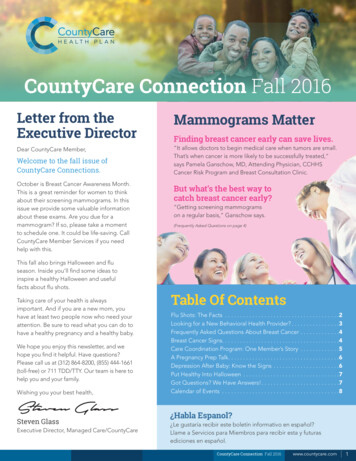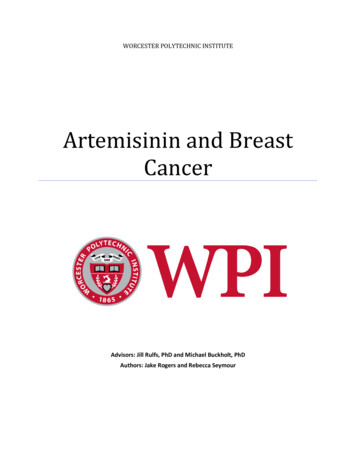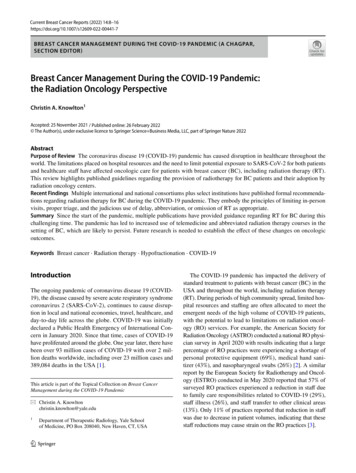
Transcription
Current Breast Cancer Reports (2022) 7BREAST CANCER MANAGEMENT DURING THE COVID-19 PANDEMIC (A CHAGPAR,SECTION EDITOR)Breast Cancer Management During the COVID‑19 Pandemic:the Radiation Oncology PerspectiveChristin A. Knowlton1Accepted: 25 November 2021 / Published online: 26 February 2022 The Author(s), under exclusive licence to Springer Science Business Media, LLC, part of Springer Nature 2022AbstractPurpose of Review The coronavirus disease 19 (COVID-19) pandemic has caused disruption in healthcare throughout theworld. The limitations placed on hospital resources and the need to limit potential exposure to SARS-CoV-2 for both patientsand healthcare staff have affected oncologic care for patients with breast cancer (BC), including radiation therapy (RT).This review highlights published guidelines regarding the provision of radiotherapy for BC patients and their adoption byradiation oncology centers.Recent Findings Multiple international and national consortiums plus select institutions have published formal recommendations regarding radiation therapy for BC during the COVID-19 pandemic. They embody the principles of limiting in-personvisits, proper triage, and the judicious use of delay, abbreviation, or omission of RT as appropriate.Summary Since the start of the pandemic, multiple publications have provided guidance regarding RT for BC during thischallenging time. The pandemic has led to increased use of telemedicine and abbreviated radiation therapy courses in thesetting of BC, which are likely to persist. Future research is needed to establish the effect of these changes on oncologicoutcomes.Keywords Breast cancer · Radiation therapy · Hypofractionation · COVID-19IntroductionThe ongoing pandemic of coronavirus disease 19 (COVID19), the disease caused by severe acute respiratory syndromecoronavirus 2 (SARS-CoV-2), continues to cause disruption in local and national economies, travel, healthcare, andday-to-day life across the globe. COVID-19 was initiallydeclared a Public Health Emergency of International Concern in January 2020. Since that time, cases of COVID-19have proliferated around the globe. One year later, there havebeen over 93 million cases of COVID-19 with over 2 million deaths worldwide, including over 23 million cases and389,084 deaths in the USA [1].This article is part of the Topical Collection on Breast CancerManagement during the COVID-19 Pandemic* Christin A. Knowltonchristin.knowlton@yale.edu1Department of Therapeutic Radiology, Yale Schoolof Medicine, PO Box 208040, New Haven, CT, USA13The COVID-19 pandemic has impacted the delivery ofstandard treatment to patients with breast cancer (BC) in theUSA and throughout the world, including radiation therapy(RT). During periods of high community spread, limited hospital resources and staffing are often allocated to meet theemergent needs of the high volume of COVID-19 patients,with the potential to lead to limitations on radiation oncology (RO) services. For example, the American Society forRadiation Oncology (ASTRO) conducted a national RO physician survey in April 2020 with results indicating that a largepercentage of RO practices were experiencing a shortage ofpersonal protective equipment (69%), medical hand sanitizer (43%), and nasopharyngeal swabs (26%) [2]. A similarreport by the European Society for Radiotherapy and Oncology (ESTRO) conducted in May 2020 reported that 57% ofsurveyed RO practices experienced a reduction in staff dueto family care responsibilities related to COVID-19 (29%),staff illness (26%), and staff transfer to other clinical areas(13%). Only 11% of practices reported that reduction in staffwas due to decrease in patient volumes, indicating that thesestaff reductions may cause strain on the RO practices [3].
Current Breast Cancer Reports (2022) 14:8–16The need to limit potential exposure of patients as well ashealthcare workers and staff during periods of high prevalence of COVID-19 supports decreasing the number ofpatients under treatment and the number of in-person visits.At this time, there are limited and conflicting data regarding increased risk of death or severe infection of COVID-19for patients with cancer or recent anti-cancer treatment [4,5, 6]. Nonetheless measures to decrease potential exposureof patients and healthcare providers and staff are crucial. Apositive test and/or symptoms may have a range of consequences including disruption of anti-cancer treatment, hospitalization, and/or death.Recommendations regarding adjustments in the provisionof RT for BC patients during the COVID-19 pandemic havebeen published by international and national consortiums aswell as select institutions. Published guidelines provide criteria to assist in performing proper triage to determine whichpatients can have their RT course delayed and/or abbreviatedwithout significantly compromising oncologic outcomes.One of the most comprehensive and often cited recommendations regarding BC patient prioritization in the USAwas published by the COVID-19 Pandemic Breast CancerConsortium. Members represent the American Society ofBreast Surgeons (ASBrS), the National Accreditation Program for Breast Centers (NAPBC), the National Comprehensive Cancer Network (NCCN), the Commission on Cancer(CoC), and American College of Radiology (ACR) [7 ]. InCanada, Ontario Health has published the frequently referenced “Pandemic Planning Clinical Guideline for Patientswith Cancer” [8 ]. There have been several published international endeavors including “International Guidelines onRadiation Therapy for Breast Cancer During the COVID-19Pandemic” by Coles et al. with contributors from five continents [9 ], RO guidelines published by the European Societyfor Medical Oncology (ESMO) [10 ], and recommendationscreated on behalf of the editorial board of The Breast [11 ].Several institutions including Johns Hopkins University,Memorial Sloan Kettering Cancer Center, and Yale Schoolof Medicine have shared their respective approaches to ROtreatment during the pandemic [12, 13, 14].This review explores the effects of the pandemic on radiation departmental operations as well as patient selectionand treatment. Key published guidelines are highlighted tohelp RO practices provide responsible BC treatment thatdecreases the risk of exposure to COVID-19 while providingeffective oncologic care.Basic Safety Guidelines/TelemedicineIn order to limit the spread of SARS-CoV-2, multiple published guidelines recommend that all patients plus healthcare workers and staff wear masks. This has now become9standard practice at almost all institutions [3, 15]. Screeningfor symptoms of COVID-19 and recent travel to a high-riskarea for patients with an in-person appointment either onthe phone, at the door, or both is encouraged. Temperaturescreening for patients should be performed upon entry.Visitors and accompanying caregivers/family should not beallowed. Patients with symptoms or possible exposure toSARS-CoV-2 must be tested [11 ].Multiple published guidelines recommend decreasingthe number of patients to be seen in-person to limit therisk of spread of COVID-19 among patients and healthcareworkers. The use of telemedicine is strongly encouraged innon-urgent situations and when physical examination is notparamount.Risk Stratification of Patients/TriageA common theme among the published guidelines relatedto BC care during the COVID-19 pandemic is risk stratification for proper triage of BC patients presenting for ROconsultation and care. The Pandemic Planning Guideline forPatients with Cancer published by Ontario Health providesthe basis for a 3-tiered system of Priority A (patients whoare unstable, patients whose condition is intolerable withoutalternative available treatment or immediately life-threatening, rapidly progressing potentially curable tumors, patientsalready on treatment), Priority B (non-Priority A patientswhose treatment can be deferred for a defined period of timewithout undue risk), and Priority C (patients that can bedelayed until the pandemic is over) [8 ]. The most detailedbreakdown related to triage for BC radiation is provided bythe COVID-19 Pandemic Breast Cancer Consortium, whichfollowing the concept of priority levels A, B, and C [7 ].This prioritization schema is detailed in Table 1.All guidelines stress the importance of approaching eachpatient’s case on the individual level looking at the clinicalsituation, patient age and comorbidities, the current state ofthe pandemic on a local level, and the risk of mortality fromCOVID-19 as compared to the risk of delay of treatment.Several published guidelines stress the importance of continuing multidisciplinary tumor board in a web-based format toallow for discussion regarding proper triage and care of BCpatients during the pandemic [10 , 11 ]. In addition, thepatient should be informed regarding the proposed treatmentcourse as well as risks and benefits. The patient’s preferencesshould be accounted for in treatment decision-making.At our institution, our weekly breast multidisciplinarytumor board has been available via remote access for atleast 7 years; however, prior to the COVID-19 pandemic,the vast majority of participants attended in-person. Startingin March 2020, the tumor board format was transitioned to100% virtual. A survey regarding the experience was sent13Vol.:(0123456789)
10Table 1 Priority categories forradiation oncology for patientswith BC during the COVID-19pandemic per the COVID19 Pandemic Breast CancerConsortium [7 ]Current Breast Cancer Reports (2022) 14:8–16Priority levelPatient descriptionA·Bleeding/painful/symptomatic local, regional or metastatic disease·Progression of disease during neoadjuvant chemotherapy·Inflammatory BC after mastectomy·LN TNBC or HER2 disease following mastectomy·4 or more positive lymph nodes·Residual and LN disease following neoadjuvant chemotherapy·1–3 positive lymph nodes following mastectomy·TNBC or HER2 , LN- s/p BCS·Positive margin for invasive cancer s/p BCS with no alternative option (TNBCtakes priority)·Positive margin s/p BCS for invasive cancer with alternative therapy options·Young age ( 40 yrs) s/p BCS, LN- with 1 high feature (LVI , PNI )·ER- DCIS with positive margin·All other DCIS· 65 yrs, early stage, LN-, ER /HER2- s/p BCS and taking endocrine therapyB1B2B3CBC breast cancer, LN lymph node, TNBC triple negative breast cancer, HER2 human epidermal growth factor receptor 2, ER estrogen receptor, DCIS ductal carcinoma in situout to all tumor board attendees in September 2020. Fiftyseven percent of respondents were “very satisfied”, 38%were “somewhat satisfied”, and 5% were “somewhat dissatisfied” with attending the tumor board in virtual format.Fifty-seven percent of respondents stated that they were“very likely”, and 19% were “likely” to continue to attendtumor board virtually after the resumption of in-personmeetings. Convenience was cited as a major factor. In addition, there has been an increase in attendance. For example,in September through November 2019, the mean numberof weekly attendees at the breast multidisciplinary tumorboard was 29.8, and the median number was 28.5. In September through November 2020, the mean number of weeklyattendees increased to 48.2, and the median number was 48.Omission of Radiation TherapyAll of the published guidelines reviewed recommend consideration of omission of RT for elderly BC patients in thepost-operative setting who meet certain criteria, typicallyage 65 or 70, tumor 2 or 3 cm excised with negative margins, ER , Her2- and lymph node negative and for whomendocrine therapy is planned.For patients with invasive BC, based on the results ofCALGB 9343 at 12.6 years of median follow-up, omission of post-lumpectomy RT for BC patients with estrogenreceptor positive tumors 2 cm in size excised with negativemargins (defined as no tumor on ink) and negative lymphnodes (clinically and/or pathologically) who take Tamoxifenhas been shown to have no effect on breast cancer-specificsurvival, overall survival, and time to distant metastasis.There was a statistically significant increase in freedom fromlocal–regional recurrence with RT (90 to 98%); however,13the lack of overall survival, breast cancer-specific survival,and distant metastasis-free survival with the inclusion ofradiotherapy support its omission in this population [16].At the time of publication of the reviewed guidelines,only the 5-year results of the PRIME II trial were available. This randomized trial included women aged 65 yearswith hormone receptor-positive breast cancers up to 3 cmstatus-post-lumpectomy with negative margins ( 1 mm)and pathologically lymph node negative who were receiving endocrine therapy. Grade 3 tumor histology or lymphovascular invasion was permitted but not both. Patients wererandomized to whole breast RT or observation. At medianfollow-up of 5 years, the rate of local recurrence was 1%in the RT arm and 4% in the no-RT arm. There was no difference in overall survival, regional recurrence, and rate ofdistant metastasis. Only 3% of patients in the study had agrade 3 tumor which limits the applicability of these resultsto that group of patients [17].Of note, the 10-year results of the PRIME II studywere recently reported at the San Antonio Breast CancerSymposium in December 2020. The rates of local recurrence in patients who did not receive RT were significantlyincreased compared to the RT arm (9.8% vs 0.9%). Therewas also a significant increase in regional recurrence whenradiotherapy was withheld (2.3% vs 0.5%). There was nosignificant difference found in breast cancer-specific survival, overall survival, and rate of distant metastasis. Mostdeaths were due to causes other than breast cancer. Thisprovides additional support for withholding radiotherapy forpatients 65 years of age who meet this criteria, especiallyduring a time of scarce resources and the need to limit exposure to others [18].Another group of patients for whom omission of RTcan be considered is those with hormone receptor positive
Current Breast Cancer Reports (2022) 14:8–1611ductal carcinoma in situ (DCIS). Appropriate patients withDCIS who can forgo RT are those with mammographicallydetected lesions 2.5 cm, low or intermediate grade, andexcised with negative margins 2 mm and over 40 years ofage [13].Delay of Radiation TherapyFor patients who do not fit the criteria for urgent RT, delayallows departments to minimize the number of patientsbeing treated during periods of greater demand on hospitalresources and high community spread. Delay of a determined amount of time, often 6–12 weeks, should be utilizedfor patients whose oncologic outcomes will not be adverselyaffected. Most patients fall into this group. This is a diversegroup of patients who must be properly triaged to determinewhat constitutes an acceptable delay while balancing the riskof infection versus the risks of postponement of treatment.Each case must be considered on an individual basis.It is logical that higher risk patients should have a shorterdelay than patients with a lower risk BC. There are concerns regarding a potential increased risk of recurrence withdelay of radiation therapy [19]. The risk stratification recommendations published by the COVID-19 Pandemic BreastCancer Consortium as outlined in Table 1 provides a basiswhen determining what would constitute an acceptable delaythat balances the risk of infection and oncologic outcome.For patients with hormone receptor positive BC, endocrinetherapy should be started during the waiting period for RT.For most priority B patients, delay from 6 to 12 weeks isacceptable depending on risk factors. The acceptable timeperiod for delay can range from as short as 6–8 weeks forhigher risk patients (i.e., inflammatory BC post-mastectomy)up to 16–20 weeks for patients with early stage cancer s/plumpectomy with negative margins (preferably 2 mm),lymph node negative, hormone receptor positive patientswho take endocrine therapy, and 50 years of age [20,21, 22]. Nonetheless, regardless of priority and risk factors,Table 2 Moderatehypofractionation and ultrahypofractionation RT regimensfor the treatment of BCdelay should be minimized taking into account availablehospital resources and local prevalence of COVID-19.Abbreviated Radiation Treatment CoursesDuring the pandemic, when resources are tight and the riskof exposure to SAR-CoV-2 is elevated, the use of abbreviated RT courses is encouraged. Available techniques aremoderate hypofractionation, ultra-hypofractionation, omission of boost, simultaneous integrated boost (SIB), andaccelerated partial breast irradiation (APBI).The use of moderate hypofractionation for whole breastRT following lumpectomy without inclusion of regionallymph nodes has been well-studied and was already considered standard of care in many countries including theUSA prior to the COVID-19 pandemic [11 , 23]. Standardmoderate hypofractionation courses for whole breast RT are40 Gy in 15 fractions [24] and 42.5 Gy in 16 fractions [25].If boost is utilized, 10 Gy in 4 fractions is prescribed in lieuof the traditional 5 or 8 fraction boost. An additional fraction of 2.5 Gy can be considered in the setting of high-riskfactors such as young age and/or a close or positive margin[23].At the onset of the pandemic, moderate hypofractionationregimens had not been widely adopted in the USA in thesetting of PMRT. The data regarding use of moderate hypofractionation in the setting of regional nodal RT and postmastectomy RT is less robust [26–28]. There is a growingbody of maturing and accruing prospective and randomizedtrials examining use of moderate hypofractionation in PMRTwith and without reconstruction which suggests that thereis confidence in equivalence in clinical outcomes, as shownin Table 2. Based on available data, early adoption of theseregimens is reasonable during a crisis of limited resourcesand risk of exposure to SARS-CoV-2. Caution is advised forpatients 45 years of age, triple negative cancers, extensivenodal involvement, and residual disease after pre-operativechemotherapy [12]. Based on physician judgment, thesepatients may be better served by conventional fractionation.RT typeFractionation schemesRelevant publications/trialsWhole breast·2.67 Gy 15, daily·2.66 Gy 16, daily·5.7 Gy 5, once weekly·5.2 Gy 5, daily·6 Gy 5, every other day (IMRT)·2.9 Gy 15 CW; 2.5 Gy 14 RN, daily·2.66 Gy 16, daily·2.67 Gy 15 CW; 2.67 Gy 14 RN, daily·2.5 Gy 4, dailyUK START B [24]Whelan et al. Canadian [25]FAST [29]FAST-Forward [30]APBI-IMRT-Florence Trial [31]Wang et al. Chinese phase III [28]NCT03414970NCT03422003 (FABREC)ASTRO guidelines [23]Partial breastPost-mastectomyBoostRT radiation therapy, BC breast cancer, IMRT intensity-modulated radiation therapy, RN regional nodes13
12Ultra-hypofractionation including the FAST regimen(28.5 Gy in 5 fractions delivered once-weekly) and theFAST Forward (26 Gy in 5 fractions over 1 week) may alsobe used for patients with early stage BC (T1-2, N0) statuspost-lumpectomy who do not require nodal treatment or aboost. Evidence to support these regimens has strengthenedsince the initial publication of the reference guidelines. Tenyear results from FAST, a phase III trial showing equivalentoutcomes in regard to local recurrence and normal tissueeffects for the FAST regimen (28.5 Gy in 5 fractions onceweekly), were recently published [29]. Our institution hasoffered FAST to appropriate candidates since publicationof the full manuscript detailing the 10-year results. The5-year results of the phase III FAST Forward trial were alsorecently published showing non-inferiority of 26 Gy in 5fractions delivered over 1 week compared to 40 Gy in 15fractions in regard to local control and normal tissue effects[30]. Due to the shorter term follow-up, this regimen shouldbe adopted with caution; however, during the unique conditions of a global pandemic, the use of this regimen forappropriate patients who are aware of the risks and benefitsis reasonable. Table 2 outlines published hypofractionationregimens to be considered for use and supporting data.Published guidelines recommend judicious omission oftumor boost during the pandemic. Boost should be reservedfor patients of higher risk of local relapse. Examples ofhigh-risk factors include age 40–50, residual disease afterneoadjuvant chemotherapy, high-grade tumor, and positivemargin. SIB can be considered; however, phase III dataregarding its use are not yet available [32].The thoughtful application of APBI for appropriate casesis also advocated in several published reports. Brachytherapyis discouraged because it adds additional strain on hospital resources and entails longer and more involved hospitalvisits [10 , 13]. Conventional external beam APBI is delivered in 38.5 Gy in 10 fractions BID. To further limit visitsto the department, 30 Gy delivered in 5 fractions deliveredevery other day using intensity-modulated radiation therapy (IMRT) is an option for departments with the necessaryexpertise [31]. APBI should be limited to patients who fitASTRO’s suitable classification. APBI may be consideredfor patients in the cautionary group especially during moreactive periods of the pandemic [33].Interruptions in Radiation TreatmentInterruption of anti-cancer treatment including radiationtherapy is recommended for patients who test positive forCOVID-19 until they are medically cleared and transmission-based precautions can be discontinued [34]. This isfor the protection of both the patient and staff. The Centerfor Disease Control provides detailed guidelines providing13Current Breast Cancer Reports (2022) 14:8–16when discontinuation of transmission-based precautions canoccur. The use a symptom-based strategy is preferred, withisolation periods of minimum of 10 to 20 days since onset ofsymptoms based on initial severity of disease and immunocompromised state of the patient, at least 24 h since last feverwithout use of fever-reduction medication, and improvementof symptoms [35]. Of note, a recent meta-analysis indicatesthat RT is not associated with an increased risk of severedisease or death from COVID-19 [36]; however, caution isadvised as data remain limited. In limited cases for patientsconsidered Priority A when interruption in treatment maybe life threatening or have a significant deleterious effect ononcologic outcome, continuing to treat can be consideredon a case-by-case basis. These patients should be treated atthe end of the day after all patients and non-essential staffhave left. Treating staff must wear full personal protectiveequipment.In September 2017, Puerto Rico was devastated by Hurricane Maria which caused catastrophic damage leaving100% of the island without power in its aftermath. This ledto interruption in RT for essentially every patient undergoing radiation on the island. ASTRO assembled a panel ofexperts in various cancer types, including breast, to providerecommendations regarding how to manage unexpectedinterruptions in radiotherapy [37 ]. These recommendations were published in Practical Radiation Oncology andformed the basis for guidance regarding the use of alteredfractionation to compensate for a 2–3-week interruption intreatment. Similar compensatory fractionation schemes wereincluded in the guidelines disseminated by the COVID-19Pandemic Breast Cancer Consortium, Johns Hopkins, andYale [7 , 12, 14]. The recommendations are summarizedin Table 3. At our institution, at this time since the onset ofthe pandemic in March 2020, there have been 12 patientswho experienced delay, only one of whom had a diagnosisof breast cancer.Adoption of RecommendationsThere are multiple published reports indicating that ROdepartments adopted the recommended strategies of telemedicine as well as delay, omission, and/or abbreviationof RT designed to limit the number of departmental visitsand treatments thereby decreasing potential SARS-CoV-2exposure of patients and staff and placing less pressure onhospital resources.ASTRO surveyed RO practices in the USA from April16 to April 30, 2020. Practices reported that their treatment volume was at 68% of typical on average. Ninety-twopercent reported strategically delaying lower risk patients.Ninety-nine percent required staff to wear masks, and 98%
Current Breast Cancer Reports (2022) 14:8–16Table 3 Recommendations fordose compensation for patientswith BC following a 2–3-weekdelay in RT. Adapted from Gayet al. [37 ]13RT typeRecommendationsWhole breast only·Continue with originally planned fractionation·Adjust boost as follows:-If initial plan did not include boost: add 2 Gy 5 fraction boost-If sequential boost planned: add one 2 Gy fraction per weekmissed up to 66 Gy to lumpectomy cavity PTV or change boost to2.3 Gy 5-If original boost was to 66 Gy, increase up to 70 Gy (consideringreducing the volume size to highest risk area)·Same as above but boost volume is mastectomy scar PTV·Adjust dose to a maximum of 50 Gy in 2 Gy fractionsChest wall (CW)RNI with whole breast or CWBC breast cancer,RT radiation therapy, PTV planning target volume, RNI regional nodal irradiationwere screening patients prior to entry. Ninety percent ofpractices reported limiting visitors. Eighty-nine percentwere offering telemedicine for patient consultations [2,15].Belkacemi et al. reported upon their single institutionalexperience in Paris during the initial wave of the COVID-19pandemic. Telemedicine was vigorously instituted includingfor weekly on treatment visits. After March 13, 2020, 50patients who had undergone CT simulation including 6 whowere already on treatment were identified at chart rounds aseligible for delay or shortening of their treatment course.Sixty-four percent of the identified cases were BC patients.Among the 50 cases identified, 22 had delay of treatment.Thirty-nine percent of those with delay in treatment were BCpatients of whom the majority received endocrine therapyduring the waiting period. Twenty one out of the 50 patientswere BC patients who received a hypofractionated course.From March 15 to May 31, 2020, the expected number offractions delivered would have been 1383; however, withdelay of treatment and the use of hypofractionation forappropriate BC and other patients, the number of actual fractions delivered was decreased to 683, a 50% reduction [38].A national survey of RO practice patterns in Switzerlandduring the COVID-19 pandemic was conducted by Achardet al. in April 2020. Telemedicine was rapidly instituted atall centers. Results were mixed regarding implementationof the recommended strategies to omit, delay, and abbreviate radiation courses. For example, 50% of centers reportedomitting RT boost in lower risk patients. Only 9% of centersomitted RT in patients 65 years of age with ER invasivetumor measuring 3 cm with clear margins, grades 1–2, andlymph node negative who planned to take endocrine therapy.Fifty percent of RO centers reported the use of endocrinetherapy to delay start of RT in ER early stage BC or DCIS.It is notable that there was an 18% increase in the percentageof centers providing moderate hypofractionation (i.e., 15 or16 fraction regimen) compared to prior to the pandemic,with an increase from 64 to 82%. Only 1 center, representing5% of respondents, reported using ultra-hypofractionationwith the FAST or FAST Forward regimen [39].A similar survey was conducted by the European BreastCancer Research Association of Surgical Trialists (EURBREAST) in April 2020 with responses mostly from publicor university-affiliated hospitals treating over 300 cases peryear from 41 countries with most being located in Europe.51.9% of responding institutions reported that they made nochanges in RT offered for BC patients. RT was postponed forlow-risk patients at 22.6% of represented facilities. 15.9% ofrespondents reported implementing moderate hypofractionation, and 7.4% reported implementing ultra-hypofractionatedregimens [40].Other departments report more aggressive adoption ofultra-hypofractionation. For example, in a letter publishedin December 2020, Guy’s Cancer Centre in London reportedthat they began to offer the Fast Forward regimen to suitablepatients due to the pandemic starting in March 2020. FromMarch 1 through May 7, 2020, there were 121 patients withearly stage BC deemed suitable for ultra-hypofractionatedtreatment, which is a decrease in patient volume by 19%from the year prior reflecting the omission of RT. Duringthis time period, 53% of patients received the FAST Forwardregimen, 46% received moderate hypofractionation (40 Gyin 15 fractions), and only 1 patient received 50 Gy in 25 fractions. Note that all cases of in situ cancer received moderatefractionation [41].A group of 20 expert panelists reviewed 54 publicationsincluding 233 recommended adaptations in dose fractionation during the COVID-19 pandemic and compared thequality of evidence supporting established dose fractionation schemes commonly employed in the pre-COVID eraas compared to the shortened courses recommended forthe in-COVID era. The panel found that for curative-intentfractionation schedules, pre-COVID fractionation courseswere more likely to be supported by high-quality evidence(51.4%) as opposed to expert opinion (4.8%). Recommendedin-COVID hypofractionation schedules demonstrated thereverse, with 5.6% supported by high-quality evidence and13
1449.3% deemed to be expert opinion. In the realm of BC,however, it was noted that the use of moderate hypofractionation was already supported by high-quality evidenceand the use of ultra-hypofractionation (5 fractions) was supported by moderate quality evidence such that the differencein the levels of evidence between the highest-quality schedules to the recommended in-COVID fractionation schedulesis described as “minimal” [42]. For this reason, it is likelythat man
was published by the COVID-19 Pandemic Breast Cancer Consortium. Members represent the American Society of Breast Surgeons (ASBrS), the National Accreditation Pro-gram for Breast Centers (NAPBC), the National Comprehen-sive Cancer Network (NCCN), the Commission on Cancer (CoC), and American College of Radiology (ACR) [7 ]. In
